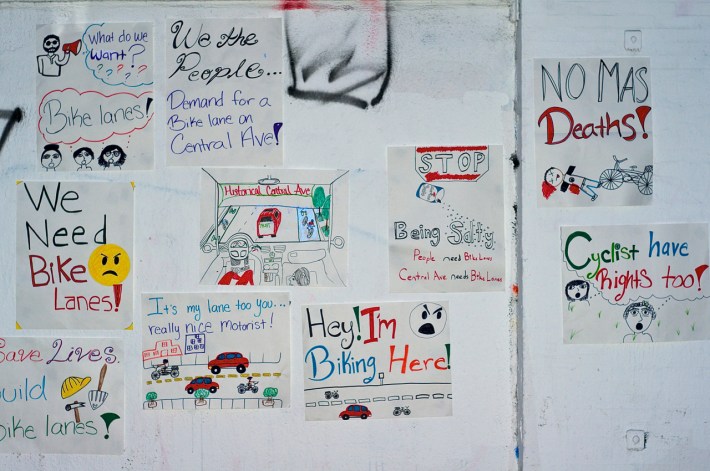
"Bottom line is, citizens want to be involved, they want to be engaged in the process of figuring out how we reprogram our streets, how we reprogram our communities, making it more livable, making it more desirable, making it safer."
So said councilmember for the 9th District, Curren Price, when interviewed by KCET's Nic Cha Kim at CicLAvia: South L.A. in December of 2014 (minute 4:20).
It is a perspective that many who live, work, play, and move along the Central Avenue corridor in historic South Central share.
Given that the corridor communities have a median income hovering around $30,000, an average household size between of 4 and 9 people, a median age of 23, and little opportunity for economic advancement thanks to limited access to higher education, area residents are very much at the mercy of their environment. Rapidly rising rents and the lack of affordable housing around the city make it nearly impossible for them to move anywhere else. And the high dependence of many families on transit, cycling, and walking to get back and forth to work and school means that just going about their daily lives entails constant flirtations with danger.
Central Avenue, boasting the highest number of cyclists anywhere in the city during peak hours (and a very steady stream in off-peak hours), has seen nearly 300 collisions between drivers and pedestrians or cyclists over the last decade.
That we know of, that is.
Many of those who have been hit by cars have never reported the incidents to authorities, either because they preferred to handle things informally with the driver, the injuries were minor, or the incident was a hit-and-run and they saw no point.
So, even though more than three-quarters of residents are renters, the vast majority would tell you they are deeply invested in the well-being of their neighborhoods and would like nothing better than to see them become safer and healthier places for all.

Thus far, however, efforts to get Councilmember Price to sit down and have that conversation with stakeholders about their needs and aspirations have proven futile.
Over the past year, the community has been shut out of discussions about Great Streets' and the councilmember's plans to remake Central Avenue in the image of Broadway (downtown) and to remove the Central Avenue bike lane planned to help bike commuters get safely between Watts, historic South Central, and jobs downtown from the Mobility Plan altogether.
The Great Streets plans for the street were only made available to the public after Streetsblog published an article complaining about the blatant steamrolling of the community. When local stakeholders tried to follow up by delivering letters to the councilmember's office and approaching the members of the Business Improvement District, they were still not able to get any response from Price to their demands for a bike lane.
Fed up with failed attempts at peaceful engagement and concerned that Price would once again try to see Central Ave. removed from the Mobility Plan at tomorrow's city planning commission hearing, residents took action. Gathering their signs, courage, a megaphone, and a banner to be hung on Price's building, they stormed the councilmember's constituent center at Vernon and Central yesterday.
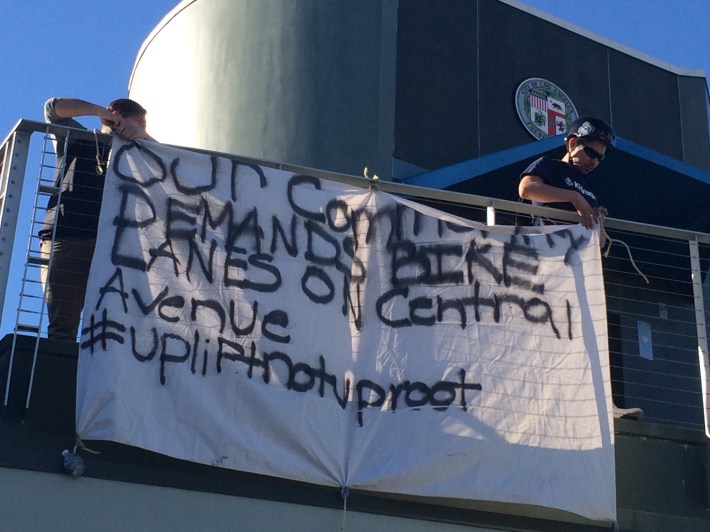
"We're tired of coming to you!" said resident and safe streets advocate AsSami AlBasir El.
"When are you going to come to our* office?" he continued. "I'm asking...when are you coming down to have a dialogue?...What solution do you have?" [*He was referring to the conference room at TRUST South L.A., where residents, volunteers, and stakeholders regularly meet, discuss community problems and potential solutions, and plan community engagements as part of a mobility advisory council.]
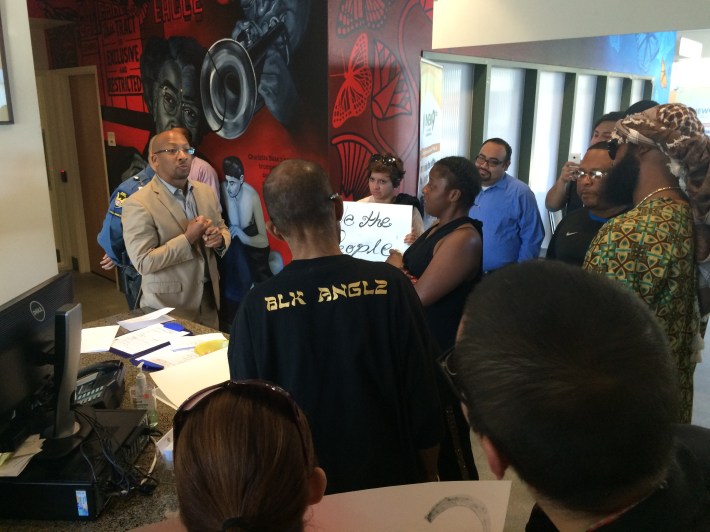
Staff on site were not able to offer much in the way of reassurances.
When District Director James Westbrooks was asked by AlBasir El if he would be willing to tell the kids standing there -- kids that are regularly transported back and forth to school by bike along Central Avenue -- that "we're not gonna have a bike lane," there was not much Westbrooks could say.
Price made up his mind on the subject a long time ago.
Sadly, the logic used to reach that decision -- detailed in a statement emailed in response to stakeholders' action -- seems rather questionable.
For one, Price says that safety is the key reason it would be difficult to add lanes to Central Avenue. Arguing it is "too narrow, has significant cut-through traffic all day, and has no pocket lane for left-hand turns," he says there is no space for a lane.
But the narrowness of the street would really only be an issue in the context of the extension of the sidewalks, as suggested in the Great Streets plan, for the very brief section of Central between Vernon and Adams. That plan (below) would put the street on a road diet and, instead of using valuable road real estate to carve out space for cyclists, install planters and bollards to make it feel like the pedestrian space had been extended.
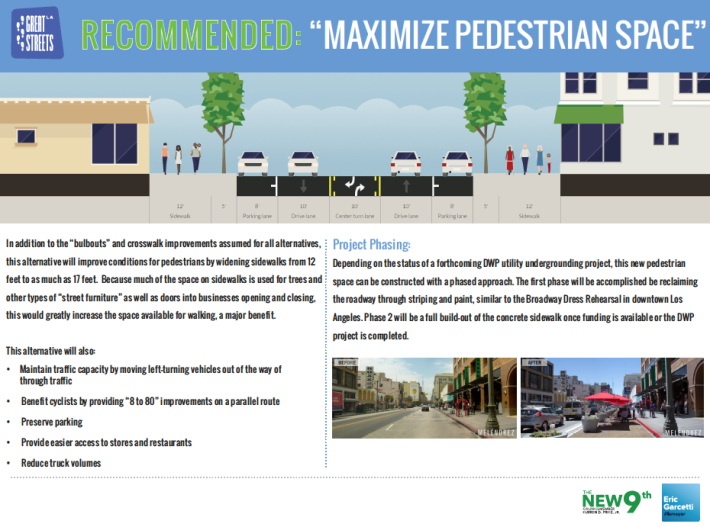
The concrete sidewalks themselves would only be extended if funding should become available (as noted in the image, above) -- something not likely to happen for several years, at the earliest. Meaning that most of the street space "reclaimed" by Great Streets would likely go underutilized, possibly for years.
Meanwhile, instead of taking the option to head a half-mile east to Avalon or a parallel side street (as suggested by Price and the Great Streets program), cyclists would likely continue to ride on the narrow and crowded sidewalks they ride on now (antagonizing business owners hoping to create an enticing pedestrian environment) or further slowing traffic by riding in the single traffic lane created by the road diet.
No one wins in that scenario.
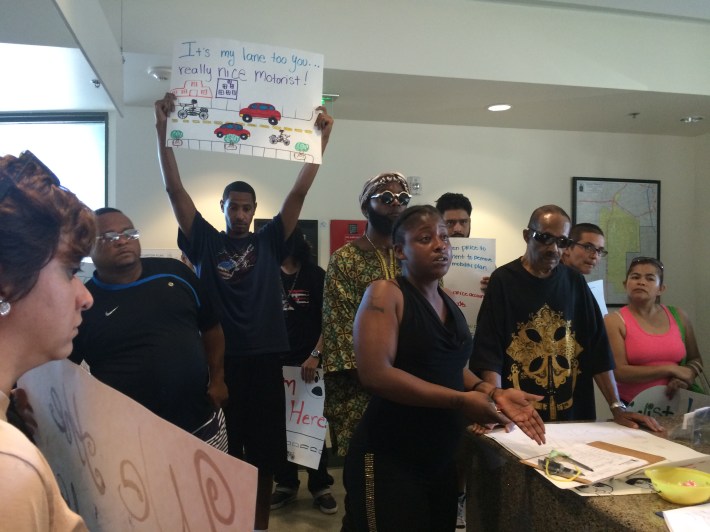
But it's Price's other point that really drives stakeholders crazy.
"As a grandfather of small children," his statement continues, "I would feel uneasy riding our bikes along this busy thoroughfare knowing the dangerous implications."
Yes!
Exactly!
This is exactly the reason stakeholders finally stormed his office yesterday!
They are tired of being uneasy and they are tired of feeling that they are constantly in danger!
Unlike Price, however, because they are lower-income, are patrons of shops on Central, have kids in schools along the corridor, work along the corridor, and reside along the corridor, they don't have a choice about where to ride.

As explained in depth here, gang activity makes the side streets a very difficult proposition for youth, lone commuter cyclists, and families. Busy thoroughfares like Central Avenue offer lots of eyes, familiar faces, and potential safe havens. And, it is one of the few streets in the area that offers a straight shot between the downtown warehouses (where many of the commuters work), historic South Central, and Watts.
For folks who are trying to get to work on bikes that are in questionable condition because they can't afford better ones or who have kids in tow, having to travel as much as a mile out of their way just to access a short stretch of bike infrastructure can also constitute a real hardship. The city would never ask drivers to make such a detour or to take the least safe route. It makes no sense to put that burden on the shoulders of the most vulnerable of L.A.'s citizens.
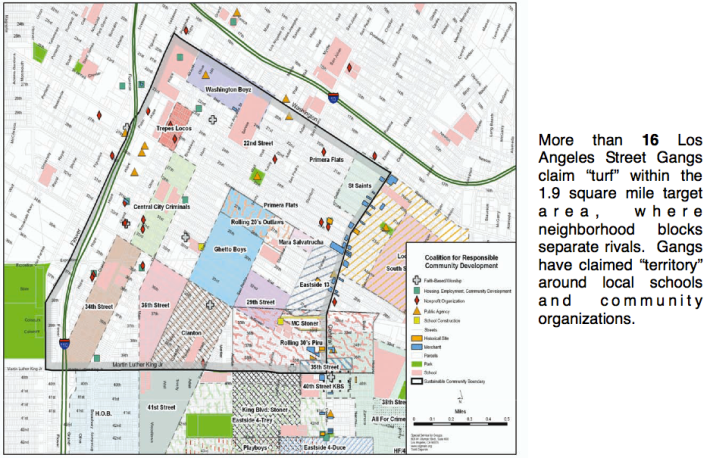
South Central cyclists are the economic engine of the community.
The vast majority are riding out of necessity: they can't afford transit, work off-peak hours, are making deliveries between small businesses, or have to get to several sites in a short space of time.
Their existence is already precarious.
The least the city can do is offer them slightly safer passage so they can bring home a salary to their families, get their kids to school safely, patronize local businesses, and continue to build a stronger community.
If, as Price contends, he takes seriously his responsibility "to make the best...decision on behalf of the entire community," then hopefully he will rethink his effort to see the Central Avenue bike lane removed from the Mobility Plan.
Disadvantaging his constituents who struggle the most does not uplift the community.
It undermines it.






